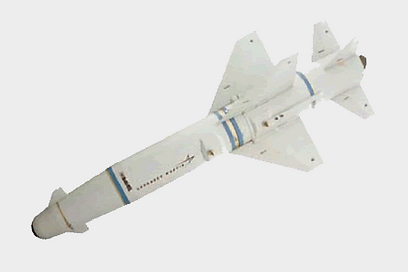

Jets which struck Syria did so while flying above Lebanese airspace and using missiles operated under stand-off technology, according to Reuters and other sources. These missiles allow for high accuracy while launching dozens of kilometers from a target.
Though Israeli confirmation of the strike was only done anonymously, analysts note that IAF arsenal includes several stand-off missile variations, among them the Popeye and the Spice-2000 – both manufactured by Rafael Advanced Defense Systems. The Spice became operational in 2003 and its use went public over the last six years.
Related stories:
The Spice system allows for "drop-and-forget" launch mode, meaning that once it is launched, it requires no additional guidance. The Spice can hit targets at up to 60 km.
Spice-2000: Autonomous operations, visual targeting
An autonomous missile, the Spice can be pre-programmed with a photograph of its target, and knows to hone itself in on it. The Spice is known for its destructive capabilities, its ability to perform accurately under any weather conditions, and its ability to remain neutral to attempts at disruption or deception by the enemy.
A missile expert who spoke with Ynet estimated that the Air Force used the Spice-2000 in its most recent strikes on Syria. According to the source, the Spice-2000 provides “high accuracy at low risk. It is immune to disruption, due to the fact that you provide early visual intelligence, thus making it unnecessary to use the GPS, which can be distorted.”

Spice missiles on IAF jet (Photo: Rafael Advanced Defense Systems)
The missile has another benefit, in the form of a reduced radar signature. While the Popeye has a rocket motor which burns fuel and makes it detectable, the Spice glides toward its target using wings. “This is a missile which saves on the preliminary flight over a target, makes visual contact with its target, and also avoids anti-aircraft systems,” the source said,
Popeye: Sends video to operator
The Popeye is considered one of the big development successes of Israel’s military industry. Since its development in the 1970s and its introduction to the Air Force in 1985, it has been sold to foreign militaries including the US, India, Turkey, South Korea and Australia. Its use was first publicized in the media during the Gulf War, when a US B-52 bomber was photographed carrying it.

Popeye missile (Photo: Rafael Advanced Defense Systems)
The missile can reach land targets, including missile launchers, without being exposed to enemy anti-aircraft systems. The Popeye missile has been upgraded over the years, with one of its versions, according to foreign reports, enabling launch from a submarine.
The missile head carries a television camera, allowing for it to be directed by its operator and locked onto its target, even after launching from the plane. Additionally, the Popeye's internal navigation system leads it directly to its target. The missile carries 350 kg of explosives. It weighs 1,320 kg and is 4.5 meters in length. The Popeye can be launched against targets at sea, and is effective even at night or under adverse weather conditions.
Fateh 110: Precise, deadly, reaches Tel Aviv
A shipment of Fateh 110 missiles manufactured by Iran and meant for the Hezbollah was the target of the Israeli Air Force in an attack on Damascus International Airport on Friday, and a later attack at a military research facility north of the capital city, said Western intelligence sources Sunday morning, following the second strike.
The Fateh 110 is manufactured by Iran, and first came to view in 2001. The initial version was operational at a distance of 170 km, carrying a head of 250 kg of explosives. Since its introduction, three upgrades have taken place, all powered by solid fuel and capable of longer ranges and increased precision.
The current version shows substantial improvements over earlier productions. It went on display in Iran in 2010. According to the Iranians, it can reach a distance of 300 km and its warhead carries a half ton of explosives. In 2007, Arab and Israeli media sources reported that Hezbollah had received a number of these missiles, though the specific model was not identified.

Fateh 110 missile (Photo: AFP)
Hezbollah members were reported to have visited Iran to train in the maintenance and launch of Fateh missiles, before returning to Lebanon. According to reports, the Hezbollah also received copies of the Fateh missile, manufactured in Syria under the sponsorship of Iran. The Syrian version of the Fateh 110, known as the M-600, is considered to be the most evident threat to the Israeli home front.
It is likely that the recent shipments of arms to Syria was of this version of the missile, which possess high accuracy at up to 100 meters or less of a target. According to reports, the latest Fateh missiles are capable of reaching Tel Aviv and even further south, when launched from neighboring Lebanon.
Fateh missiles are capable of “course correction,” via small wings found on their head. Running on solid fuel, they can be launched stealthily, remaining virtually hidden almost to the moment of operation. This makes the Fateh 110 difficult to target from the air.
With these qualifications, the Fateh missile is highly coveted by the Hezbollah, and Damascus has high motivation to provide them. It is likely that these missiles are also being used by the Syrian army against the rebels.
Ron Ben-Yishai contributed to this report
- Receive Ynetnews updates
directly to your desktop















